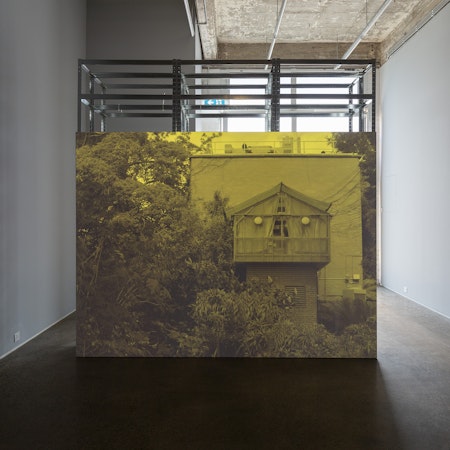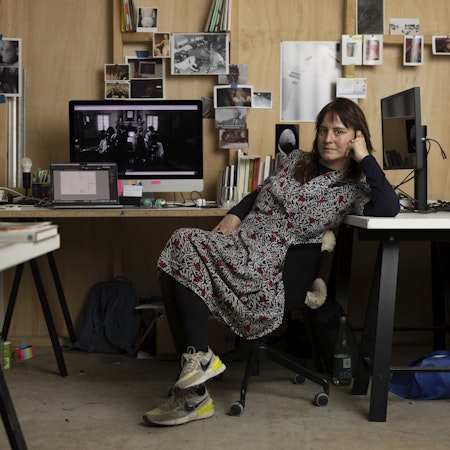The front house faced the street and the full blaze of the afternoon sun. The brutal light rendered the world as diagram, all shapes and angles, details and contradictions exposed out of existence. The ideal as filter for the real, she thought, dodging with one hand over her eyes in the direction of the path, and abruptly recalled a picture from a dream: a still expanse of very green grass against a white sky. No movement, no shadow, but a verdant humidity.
It was just possible to discern a rectangular indentation in the grass—perhaps the foundation of a long narrow building, softened by an accretion of mud and turf. She picked her way along the narrow garden under the eaves, towards the shed bordering the alley. Didn’t rhubarb once grow here? There was an article in The Star reporting twice the poverty in neighbourhoods with alleys and laneways. Some functionary proposed revitalising the laneways by naming them, a citizen said there were rats, and everyone agreed that the uninsulated wooden garages abutting them as the traditional bulwark between the main buildings and unknowable dealings of the laneways must be turned into affordable housing. It had been a long time now since tomatoes grew out of doors here.
Inside the back building, fantastic hot spots hung before her without lighting the darkness. An afterimage like magic, a light in the darkness that made everything darker. A short story in which the magician’s tricks were “interchangeable as a collection.” Was she misremembering? Did the author mean the tricks were like or unlike? Perhaps it was a poor translation, the phrase presented naked in English, with the context left behind, discarded like clothing on the floor, somewhere back in the mother tongue. Or, she thought, it might be a means of psychological sorting. In a white lab, researchers with clipboards and bland faces would propose such a statement to their subjects. Those who responded, “Yes, yes, everything in a collection is interchangeable, it’s all of a particular type” are themselves of a particular type. Those who are startled and confused by the claim are of some other type. But what are these psychological types and what could they possibly represent? There would have to be numbers, she thought, knocking her elbow on the handle of an old-fashioned rotary mower. She could see now. Not numbers but spades and rakes, brooms and shovels, shelves with stacked pots and glass jars arranged in rows, just as they had been in childhood.
The car was unlocked, in fact one of the doors was open. The battery would be dead again and she wasn’t sure she remembered how to jump start the motor. What if there were an emergency, she wondered, and then marvelled at the predictable loop of her own mind—so many emergencies. But sometimes there were emergencies and the car ought to be ready, she thought with rising irritation, seeing again the red pinhole sun in a caustic haze, hearing the shushing of plastic sheets wrenched loose from their frames, waving and snapping in the wind like the downpour that never came. Her pulse beat in her head. The air was suffocating, even with the open door. There was the water bottle, beneath the seat, hot as an incubator, surely growing something poisonous but perhaps interesting. Under a microscope, an extravagant garden with mushrooms and a caterpillar smoking a hookah. Her thoughts went inside the refrigerator at work, with its rows of covered petri dishes and forgotten takeout boxes in the crisper drawer at the bottom. Keep your temper, said the caterpillar.
The sun was like a hand laid on the back of her neck as she stepped outside and turned to pull the door to. Against the glass in one of the lower panes was a tiny votive card, a ghostly Virgin bleached cyan. Where do the reds and yellows go? How did it come to be stuck against the mullion? It must have been there for years. Years of regular observance, commonplace as water to a fish. And suddenly she saw her father’s face, the predictable expression of alarm that came over it when anybody mentioned the beliefs of his childhood. She could see him edging sideways, fleeing the conversation a little faster than what was strictly courteous, and she began to laugh. Mary, untier of knots, unkinker of hoses—make the way straight, make it flow clear.
H.A. Halpert is an artist and writer based in New York.

